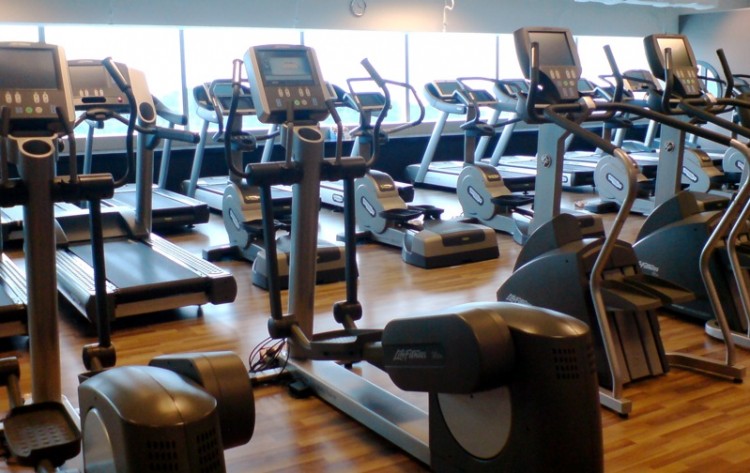Let’s say you wanted to lose weight and improve your overall fitness, what would be your first step?
My guess is it would involve dusting off your old runners, hitting the treadmill (or stationary bike, stair-master etc) for 45-60min 3-5x/wk. After all, keeping your heart rate in the ‘fat burning zone’ is a sure-bet to quick weight loss and strong ‘cardio’… right?
What if I told you that spending hours pounding the pavement each week isn’t the best strategy to get lean, strong and fit?
In fact, it can be downright dangerous.
“That’s blasphemy!” you say (or maybe another word starting with ‘b’…)
SETTING THE CONTEXT
If running, cycling, triathlon-ing or any other long-distance, steady-state activity is your thing, I’m not going to tell you to stop.
Believe me… I live with a runner (my wife) and if I told her she had to stop running I would quickly find myself on the couch!
This blog post is for everyone else who gets that puke-taste in their mouth at the sight of a treadmill or elliptical… those of you who keep putting off exercise because you have been told it has to include climbing the stairs to infinity or staring at sweaty butt cracks for hours at a time in the spinning room.
I’m here to say that, assuming your goal is to be as healthy as possible (e.g. be lean, strong and fit) IT DOESN’T HAVE TO BE THAT WAY!
What do movement and oxygen have in common?
Let’s get philosophical for a moment (a short one, I promise).
What’s the purpose of exercise anyway? I mean, is it really just to look good and feel good? These are nice side-benefits of good quality exercise rituals, but do they justify the body’s NEED for movement?
Because you are a human, we know your body has very specific requirements for movement. This comes from literally millions of years of evolution and over 200 thousand years as Homo Sapiens, during which time our genes have come to expect a significant amount of movement.
Just like we need to breath to meet our body’s requirements for oxygen and we need to drink water to meet our body’s requirements for H20, we need to find ways to meet our body’s requirements for movement, what we nowadays refer to as ‘exercise.’
We now know that movement (and the way movement is registered by your brain) is intricately linked to every aspect of our physiology – from breathing to digestion to brain development to fertility and reproduction to learning and memory.
So what does that have to do with treadmills?
Our hunter-gatherer ancestors had to move a lot in order to survive. What they didn’t do is spend an hour or 2 every day significantly elevating their heart rates (like running on a treadmill)…
They did spend many hours a day crawling, climbing, pulling, pushing, lifting, throwing, sprinting and walking at a slow pace (some nomadic tribes today still walk 10-15km/day!).
Our physiology (or we would say “our design”) is set up to handle those types of demands. When you begin elevating your heart rate for extended time periods (aka steady-state ‘cardio’ exercise) it sets off a whole chain of not-so-good changes in your body.
Let’s dive in.
Lions, tigers and bears, oh my!
You are equipped with one of the most complex, intelligent responses found in physiology called the ‘stress response.’ AKA the ‘fight-or-flight response,’ this is a super-important process in the body that has evolved over millions of year (in our evolutionary history) to give us the best chance of survival when faced with something stressful (like running away from a tiger…)
It’s actually all controlled by a specific portion of your nervous system which – when fired up – immediately shifts your body’s physiology from a healing/repair state to a protect/conserve state. You’ve probably heard of the key hormone involved in controlling these switches – Cortisol.
Chronic Cardio = Chronic Stress
All exercise necessarily involves the body shifting into a stress response and cortisol is released to direct the body’s various metabolic switches. In short duration, this is a good thing: the body has to adapt to the stressor (e.g. sprinting up the hill) and as the body recovers, it gains the benefit of being able to adapt a little bit better the next time.
Like a lot of things in life however, too much of a good thing becomes a bad thing.
Adapt Or Die
Just like we’ve all experienced the negative effect of being chronically stressed from other life events (work, family, finances, accidents, injuries etc), the same process is occurring when we drive that stress response for long periods during steady state exercise.
The challenging part in all this is that your body is so good at adapting for short term survival that it will downplay the longer-term detrimental effects, often until they pile up so high that you have some sort of significant breakdown in function.
This can manifest in different ways for different people – for some it could be a body injury like a muscle tear or joint wearing, but for others this can be more severe like heart and liver problems.
The Nitty Gritty
What sits at the root of this problem is what is called oxidative stress which results from the presence of things called free radicals.
A little bit of oxidative stress is happening all the time in the body, and this is essential for a bunch of good things like muscle growth, strength gains, learning new skills and even gaining new knowledge (remember how ’stressful’ studying for exams is?)
But when our body’s ability to deal with the oxidative stress is overwhelmed, then those same free radicals accumulate and cause damage to all types of tissues including your muscles, nerves and organs. As if that weren’t enough, free radicals can damage your DNA which can speed up the aging process.
If all that was gobbledygook, here’s the take home points:
- Movement (what we refer to as exercise) is essential for your health.
- All exercise is stressful.
- Short term stress from exercise is healthy; long-term stress from exercise is not so healthy.
So what specifically can happen when you do too much cardio?
In part 2 I will highlight the top 5 reasons why cardio is NOT king and how overtraining is wrecking your body.
Click HERE to read Part 2 now.
 Dr. John MacPhee is a Chiropractor and passionate health and wellness expert. He has inspired thousands of people to take control of their own health to achieve their extraordinary potential using the Life By Design® Model. Dr. John runs a thriving Chiropractic practice at The Wellness Group in Kanata, Ontario.
Dr. John MacPhee is a Chiropractor and passionate health and wellness expert. He has inspired thousands of people to take control of their own health to achieve their extraordinary potential using the Life By Design® Model. Dr. John runs a thriving Chiropractic practice at The Wellness Group in Kanata, Ontario.


[…] part 1 of this blog I went pretty deep into the nuts and bolts of how the body responds to exercise and the broad […]
[…] In part 1 of this blog I went pretty deep into the nuts and bolts of how the body responds to exercise and the broad effects of buying into the cardio myth. In this post I want to get specific and look at some key by-products of chronic cardio and how that may be holding you back from reaching your health and fitness goals. […]
[…] I hope you clearly understand one reason (there are more!) why that’s clearly false. (Click HERE to read more about why cardio is not […]